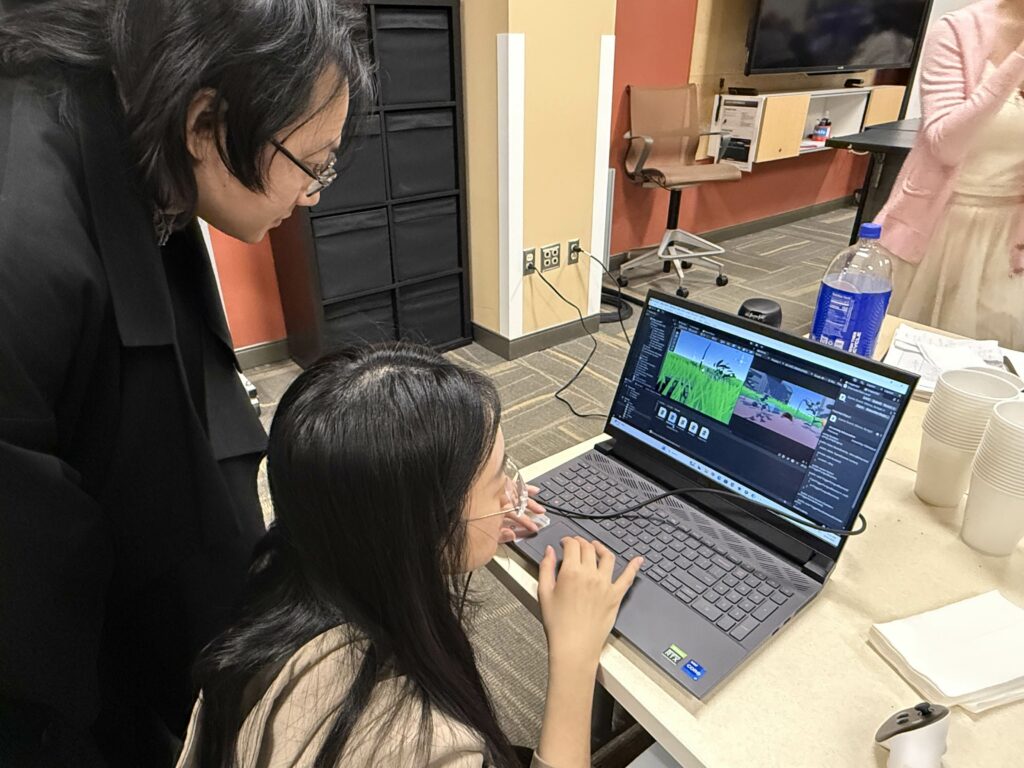Week 6 – First Playtest & Expert Interview

This week, we conducted our first playtest at Tuesday’s Playtest Night. Unfortunately, we encountered technical issues—the latest build didn’t sync to our Quest 3 headset, forcing us to spend an hour and a half debugging. As a result, we only had 30 minutes to test our world. Despite the setback, we were still able to gather valuable feedback from eight playtesters, thanks to all the event participants.
In addition to our first playtest, we had the opportunity to interview Amberlee Bozic, a Natural Resources Specialist at the US Army Corps of Engineers. She provided valuable insights into our three planned levels, offering scientific recommendations to improve their environmental accuracy.
Key Playtest Feedback
Scale & Immersion
- Players didn’t feel smaller—the sense of miniaturization wasn’t clear.
- Players missed key visual cues, such as the oversized house and squirrels, which were supposed to reinforce the scale difference.
Suggested solution:
- Start at normal size, then shrink to make the change more noticeable.
- The environment needs more exaggerated props and perspective tricks to reinforce the sense of scale.
Interaction & Dialogue
- Subtitles are needed—many players missed dialogue entirely.
- NPC conversations were unclear—text was too long, cues were hard to notice, and NPC heights felt inconsistent.
- The AI voice felt odd and distracting, making it difficult to engage with NPCs.
Difficulty & Gameplay Mechanics
- Players needed more guidance for interactions—tutorials were unclear.
- Object pickup felt confusing—leaves were easily thrown or dropped unintentionally.
Suggested solution:
- Two-hand pickup system
- Clearer prompts
- Better controller mapping.
Art Style & Visual Consistency
- Players expected a stylized, fantasy, cartoon-like aesthetic with high saturation.
- Some elements felt unfinished or inconsistent—for example, leaves didn’t match the rest of the environment.
- Playtesters wanted more cohesive, interactive elements (flowers, houses, etc.).
Key Takeaways & Next Steps
One of the biggest surprises was that players didn’t realize they had shrunk—this suggests that the character-to-environment scale wasn’t correct. We noticed some object sizes weren’t consistent, which we’ll address in future iterations to better reinforce the sense of miniaturization.
Another challenge was the AI voice-over—some players found it distracting or not engaging enough. Others mentioned they would prefer subtitles, but implementing subtitles in a VR world could break immersion. Finding the right balance between audio cues and readable information will be an important design challenge moving forward.
For the next iteration, we’ll focus on:
- Refining scale and environmental cues to better communicate the player’s size.
- Improving dialogue presentation, possibly adjusting NPC interactions and voice-over clarity.
- Enhancing object interactions, making pickup mechanics more intuitive.
- Polishing the art style to create a more cohesive and immersive world.
This playtest gave us critical insights, and we’re excited to apply these learnings to improve player experience in future iterations!
Original Level Concepts & Expert Feedback
Under-Tree Level: Collecting Leaves to Make Nutrients
Original Idea: Players collect fallen leaves to create nutrients for the soil.
Expert Feedback:
- Leaves contain essential nutrients that help feed the soil and plants.
- Oak leaves are okay, but maple leaves are better for soil health.
- Pine needles are not ideal—they’re acidic, which benefits some soil types but isn’t great for grass.
- Good soil is dark brown, cool, and moist—this can be used as a visual cue in-game.
Reinforce the message: “Don’t throw leaves away”—they enrich the ecosystem instead of becoming waste.
Next Steps: Adjust leaf types in the game and emphasize how different leaves impact soil health.
Upper-Tree Level: Building Nests for Wild Animals
Original Idea: Players help build nests for wild animals in trees.
Expert Feedback:
- Most wild animals build their own nests, but we can build birdhouses or squirrel shelters that animals will use in winter.
- Animals sometimes use garbage for nesting—if we leave trash in the backyard, they might use it.
- Example: Birds have been found using shoelaces and plastic, which can be dangerous.
- Encourage keeping the backyard clean to provide safe materials for animals.
- Use natural, clean materials to build safe shelters for wildlife.
Next Steps: Shift the focus from building nests to constructing birdhouses/shelters and highlight how litter affects animal habitats.
Pond Level: Managing Algae & Water Circulation
Original Idea: Players manage algae growth and help circulate water for a healthier pond ecosystem.
Expert Feedback:
Algae can be both good and bad:
- It creates oxygen and removes carbon dioxide, which benefits the ecosystem.
- Excessive algae growth can harm water quality.
- Introduce water testing strips as a tool to check water health.
- Keeping water circulating is essential for a balanced ecosystem.
- Using fish to grow plants (aquaponics) is another method to maintain a healthy pond.
Next Steps: Introduce water testing mechanics, clarify the positive and negative roles of algae, and consider fish-based water filtration elements.
Moving Forward
Amberlee’s feedback has given us a more scientifically accurate foundation for our game mechanics.
Our next steps will focus on:
- Refining level objectives to align with real-world ecological processes.
- Incorporating clearer visual and interactive cues for players to understand cause and effect in environmental systems.
- Emphasizing environmental responsibility, such as reducing litter to protect wildlife and using natural solutions for pond health.
This interview has been incredibly insightful, and we’re excited to implement these refinements in the next iteration of our game!
